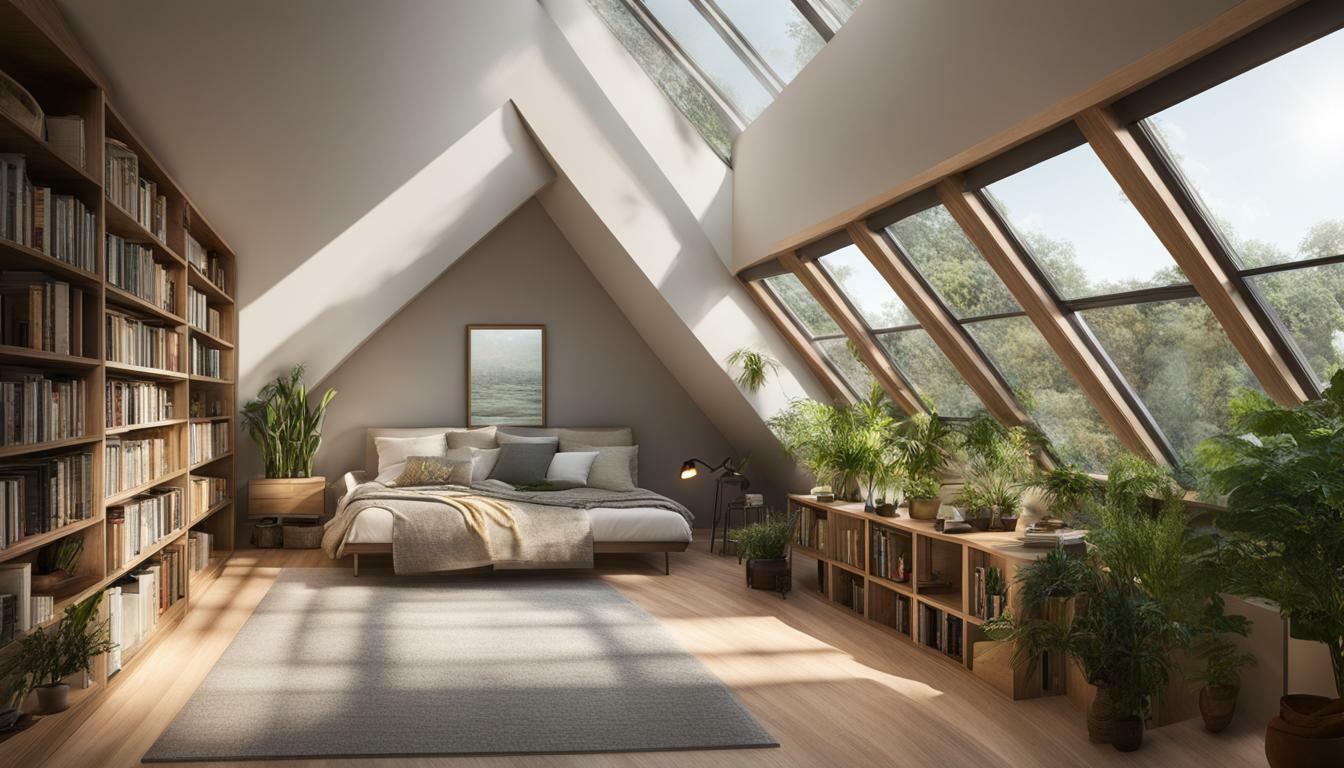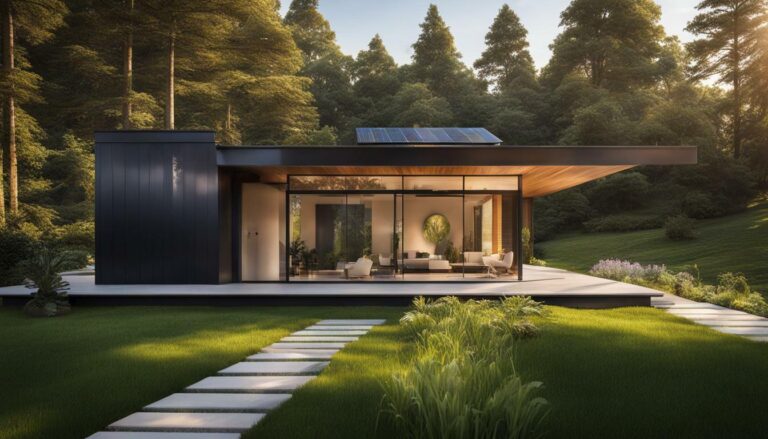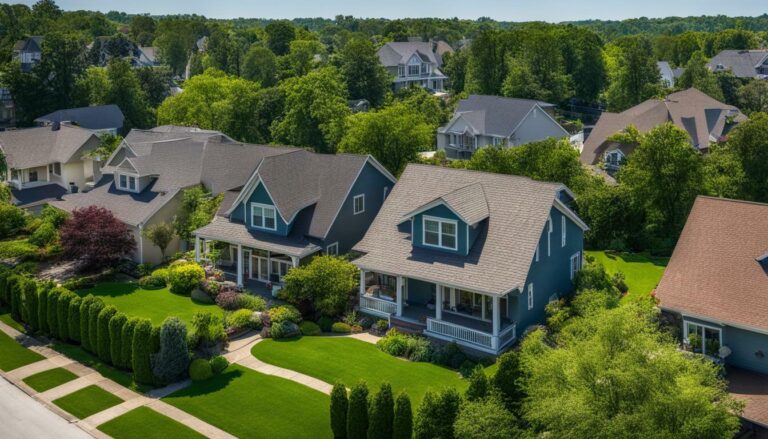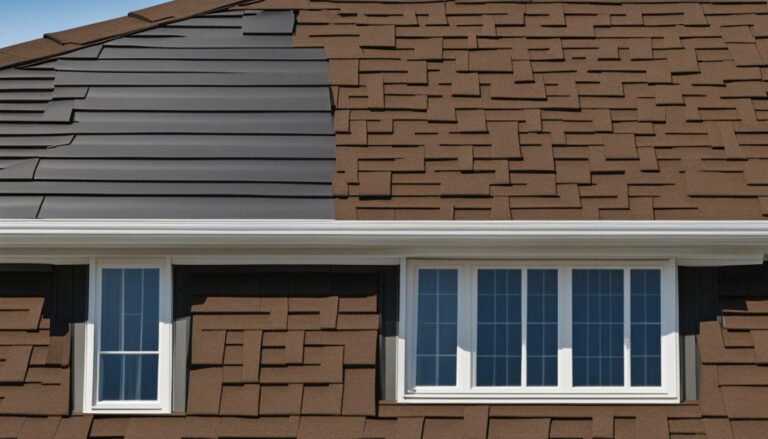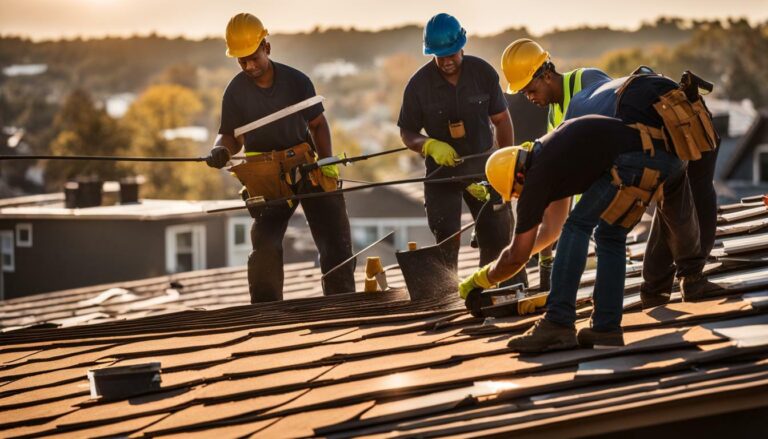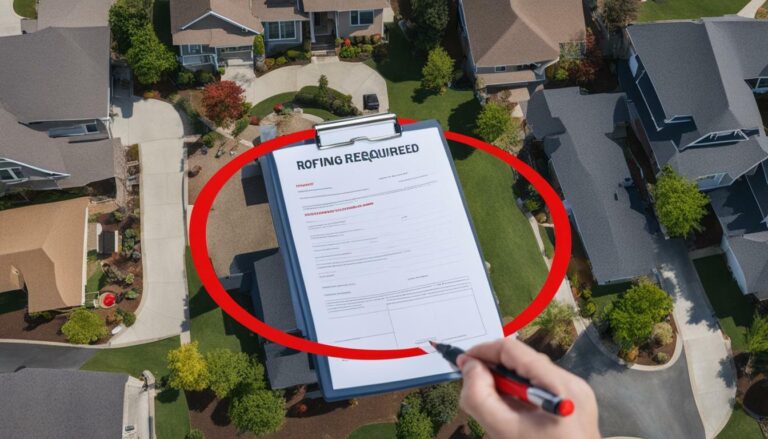Essential Skylight Installation Considerations for Your Home
Installing a skylight in your home can bring in natural light and enhance the aesthetic appeal of your living space. However, there are several essential considerations you need to keep in mind before starting the installation process. Not all roofs are suitable for skylights, so it’s important to assess your roof’s construction and suitability. Stick-framed roofs are generally better suited for skylights, while truss-framed roofs may present challenges.
Another important factor to consider is the type of glazing for your skylight. Glass is the preferred option due to its durability and insulating properties, although plastic glazing is a more affordable alternative. The location of your skylight also plays a significant role, with north-facing skylights providing continuous year-round illumination.
When it comes to installation, it’s crucial to leave it to the professionals. Skylight installation can be complex and risky, so hiring experts will ensure a safe and effective process. Regular maintenance is also necessary to keep your skylight in optimal condition. Inspecting for leaks and damage, as well as proper cleaning and care, will help extend the lifespan of your skylight.
In summary, considering these factors and taking the necessary precautions will help ensure a successful and beneficial skylight installation for your home.
Key Takeaways:
– Assess your roof’s construction and suitability before installing a skylight.
– Glass is the preferred option for skylight glazing due to its durability and insulating properties.
– North-facing skylights provide continuous year-round illumination.
– Hire professionals for skylight installation to ensure a safe and effective process.
– Regular maintenance, including inspecting for leaks and cleaning, is necessary to extend the lifespan of your skylight.
Choosing the Right Skylight
When choosing a skylight, it is important to consider the design and material options that will best complement your home’s style and architecture. Skylights come in various shapes, sizes, and styles, allowing you to find the perfect fit for your needs.
One design consideration is the type of skylight. Fixed skylights are non-operable and provide a fixed source of natural light. They are a popular choice for areas where additional ventilation is not necessary. On the other hand, vented skylights can be opened to allow fresh air into the room, providing both light and ventilation.
Skylight material options are also worth considering. Glass skylights are the most common choice due to their durability and insulating properties. They offer excellent clarity and won’t yellow or become brittle over time. Another option is plastic skylights, which are more affordable but may have a shorter lifespan compared to glass.
Furthermore, it is important to choose a skylight that suits your climate. In areas with hot summers or cold winters, selecting a skylight with Low-E coating can help reduce heat gain or loss, improving energy efficiency. Additionally, consider the tint of the skylight, as certain tints can help reduce glare and UV rays.
By considering the design and material options available, you can choose a skylight that not only enhances the natural light in your home but also complements your overall aesthetic. Remember to consult with professionals to ensure proper installation and to make the most informed decision for your home.
| Type | Design | Material | Climate Considerations |
|---|---|---|---|
| Fixed Skylights | Non-operable, providing a fixed source of natural light | Glass or Plastic | Consider Low-E coating and tint options |
| Vented Skylights | Can be opened to allow for light and ventilation | Glass or Plastic | Consider Low-E coating and tint options |
Assessing Your Roof’s Suitability
Assessing the placement and condition of your roof will help determine if it can support the weight and structure of a skylight. Not all roofs are suitable for skylight installation, so it is important to evaluate your roof before proceeding with the project. Stick-framed roofs tend to be more appropriate for skylights as they provide a solid structure for installation. On the other hand, truss-framed roofs may require additional reinforcement to support the added weight.
When assessing your roof’s suitability, it is crucial to consider any existing obstructions such as vents, pipes, or chimneys. These obstacles can affect the placement of the skylight and may require adjustments to ensure proper installation. Additionally, examining the roof’s age and condition is important, as any signs of damage or deterioration should be addressed before proceeding with the skylight installation.
Consulting with a professional contractor or structural engineer is recommended during the assessment process. They can provide expert advice and evaluate whether your roof meets the necessary criteria for a successful skylight installation. Remember, proper assessment and preparation will help avoid any potential risks or complications, ensuring a safe and secure skylight addition to your home.
Table 1: Roof Assessment Checklist
| Considerations | Actions |
|---|---|
| Roof framing type | Determine if your roof is stick-framed or truss-framed |
| Obstacles | Identify any vents, pipes, or chimneys that may affect skylight placement |
| Roof condition | Check for signs of damage or deterioration |
| Professional consultation | Seek advice from a contractor or structural engineer |
By carefully assessing your roof’s suitability and following the necessary steps, you can ensure that your skylight installation is successful and enhances the natural lighting in your home.
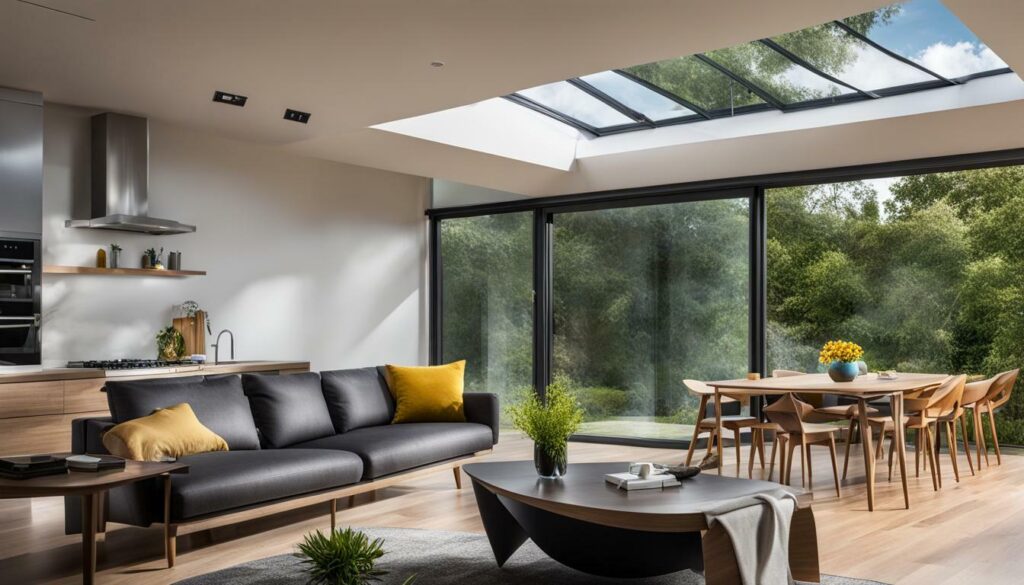
Understanding Glazing Options
The type of glazing you choose for your skylight will affect its thermal performance and energy efficiency. When considering the glazing options, it’s important to prioritize durability and insulation. Glass is the preferred choice due to its ability to withstand harsh weather conditions and provide excellent insulation, helping to keep your home comfortable throughout the year.
Glass glazing also allows natural light to pass through more effectively, providing a clear and unobstructed view of the sky above. This can greatly enhance the aesthetic appeal of your skylight and create a brighter and more spacious atmosphere in your home.
If budget is a concern, plastic glazing can be a more affordable alternative. However, it is important to note that plastic glazing may not offer the same level of insulation and durability as glass. Additionally, plastic may be more prone to yellowing and discoloration over time, which can affect the overall appearance of your skylight.
When making a decision, it’s important to consider the specific needs and requirements of your home. Consult with a professional to determine the best glazing option based on your budget, climate, and desired energy efficiency.
Comparison of Glazing Options
| Glazing Type | Benefits | Considerations |
|---|---|---|
| Glass | Durable, excellent insulation, clear view | Higher cost, heavier weight |
| Plastic | More affordable, lightweight | Less insulation, prone to discoloration |
Remember, the glazing option you choose will have a significant impact on the overall performance and efficiency of your skylight. Take the time to research and consult with professionals to ensure you make the best decision for your home.
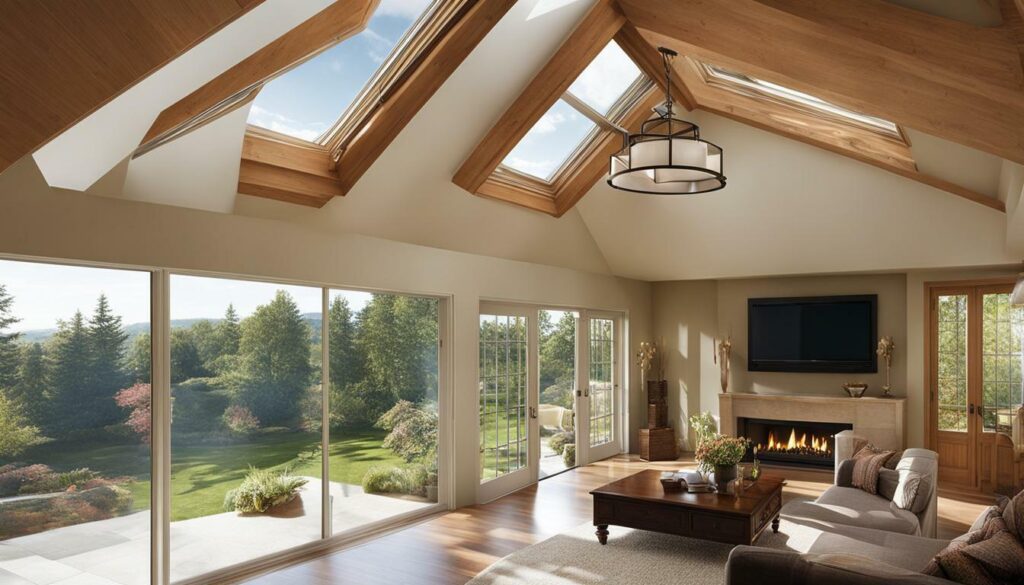
Proper skylight placement is essential for harnessing natural light and creating a bright and welcoming atmosphere. When positioning your skylights, consider the orientation and size of your home, as well as the layout of each room. North-facing skylights are ideal for continuous year-round illumination, as they receive the most consistent natural light throughout the day. However, east or west-facing skylights can also provide ample light during certain times of the day, depending on your location and the surrounding landscape.
Another important factor to consider is the size and quantity of skylights. Installing larger skylights or multiple smaller skylights in a room can maximize the amount of natural light that enters the space. Additionally, strategic placement of skylights in areas with high ceilings, such as stairwells or open concept living areas, can create a sense of spaciousness and flood the room with abundant natural light.
It is important to be mindful of potential obstructions when determining the placement of your skylights. Trees, neighboring buildings, or roof overhangs can cast shadows and limit the amount of sunlight that reaches your skylights. Prioritize skylight placement in areas where these obstructions are minimal, allowing for optimal natural light penetration.
Table 1: Skylight Placement Tips
| Placement | Tips |
|---|---|
| North-facing skylights | Provide consistent, year-round illumination |
| East or west-facing skylights | Offer ample light during specific times of day |
| Consider room layout | Position skylights to maximize natural light in each space |
| Size and quantity | Install larger skylights or multiple smaller skylights for increased brightness |
| Avoid obstructions | Place skylights away from trees, buildings, or roof overhangs that block sunlight |
Proper skylight placement not only enhances the aesthetic appeal of your home but also offers numerous benefits, such as reduced reliance on artificial lighting, improved mood, and increased energy efficiency. By strategically positioning your skylights, you can create a harmonious balance between natural and artificial light, transforming your living spaces into serene and inviting environments.
Remember, consulting with a professional skylight installer is crucial to ensure your skylights are installed correctly and in the most advantageous locations. They have the expertise to evaluate your home’s structure and guide you in selecting the appropriate size and placement for your skylights, taking into account both functionality and design aesthetics.
With careful consideration of skylight placement, you can enjoy the beauty and benefits of natural light throughout your home, making it a more pleasant and inviting place to live.
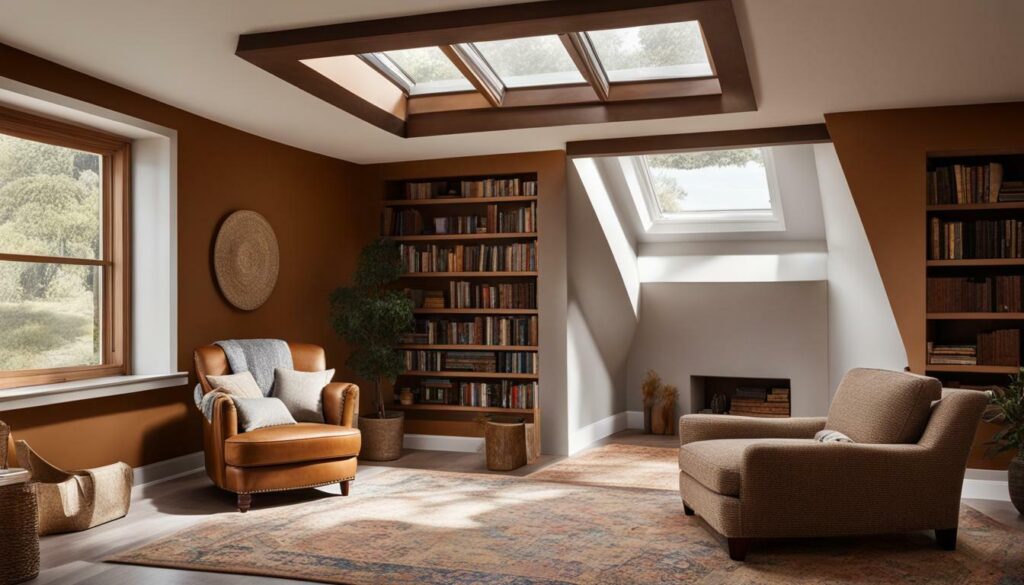
To avoid potential issues and ensure a successful installation, it is recommended to hire experienced professionals for skylight installation. Installing a skylight is a complex task that requires knowledge of roofing, construction, and waterproofing techniques. Professionals will have the expertise to assess your roof’s suitability for a skylight and determine the best placement to maximize natural light while minimizing any potential structural risks.
When you hire professionals for skylight installation, you can have peace of mind knowing that the job will be done right. They will have the necessary tools and equipment to complete the installation safely and efficiently. Additionally, professionals can help you navigate any local building codes and regulations that may apply to skylight installations.
During the installation process, professionals will ensure proper flashing and sealing to prevent leaks and water damage. They will also make sure that the skylight is securely attached to the roof, providing long-term stability and durability. By entrusting the installation to professionals, you can enjoy the benefits of a well-installed skylight without the worry of potential problems down the line.
Remember, skylight installation is not a DIY project. Hiring professionals is the best way to ensure that your skylight is installed correctly and safely, allowing you to enjoy the beauty of natural light in your home.
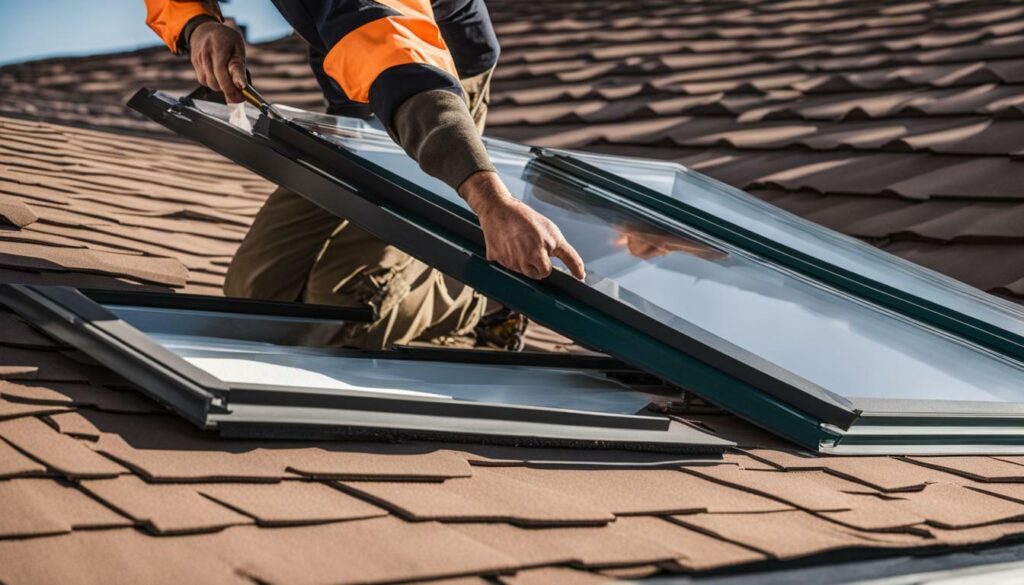
- Expert assessment of roof suitability and skylight placement
- Proper flashing and sealing to prevent leaks
- Compliance with local building codes and regulations
- Secure attachment for long-term stability
- Safety and efficiency during the installation process
By hiring professionals for skylight installation, you can ensure that your investment in natural light is protected and that your skylight will bring joy and brightness to your home for years to come.
| Skylight Installation Best Practices |
|---|
| 1. Hire experienced professionals for installation |
| 2. Consult with professionals to determine roof suitability |
| 3. Consider the optimal placement for maximizing natural light |
| 4. Ensure proper flashing and sealing to prevent leaks |
| 5. Follow local building codes and regulations |
| 6. Securely attach the skylight to the roof for stability |
Regular Maintenance and Care
Regular maintenance and care are necessary to protect your skylight from damage and extend its lifespan. By following a few simple maintenance tasks, you can ensure that your skylight remains in optimal condition. Here are some essential tips:
Inspect for Leaks and Damage
Periodically inspect your skylight for any signs of leaks or damage. Check for cracks, gaps, or loose seals around the skylight frame. Look for water stains or moisture on the surrounding ceiling or walls, as this may indicate a leak. If you notice any issues, it is essential to address them promptly to prevent further damage.
Cleaning and Care Tips
Regularly clean your skylight to maintain its functionality and appearance. Use a mild, non-abrasive glass cleaner and a soft cloth or sponge to wipe away dirt and grime from both the inside and outside of the skylight. Avoid using harsh chemicals or abrasive materials, as they can damage the glass or frame. Additionally, trim any nearby tree branches or foliage to prevent debris from accumulating on the skylight.
It is also important to regularly inspect and clean the skylight’s drainage system. Clear any debris or obstructions from the gutters or downspouts to ensure proper water drainage. This will help prevent water buildup and potential leaks.
Table: Skylight Maintenance Checklist
| Maintenance Task | Frequency |
|---|---|
| Inspect for leaks and damage | Twice a year |
| Clean the skylight | Bi-monthly |
| Clear gutters and downspouts | Bi-annually |
| Remove debris around skylight | As needed |
By following these maintenance tips and establishing a regular schedule, you can keep your skylight in excellent condition and enjoy the benefits of natural light for years to come.
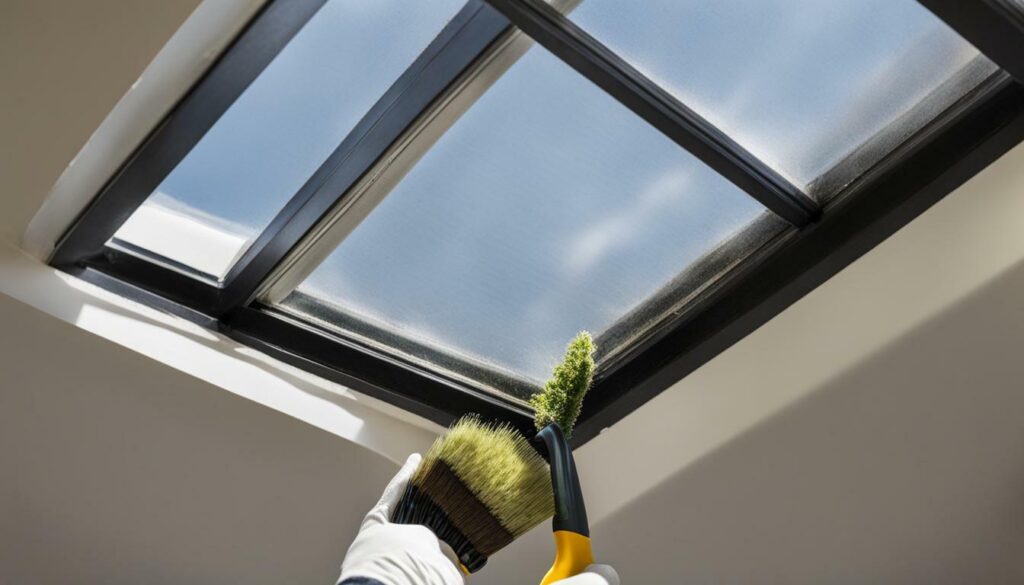
Regular maintenance and care are necessary to protect your skylight from damage and extend its lifespan. Inspecting for leaks and damage, regular cleaning, and clearing the skylight’s drainage system are essential maintenance tasks. By following a maintenance schedule and addressing any issues promptly, you can ensure that your skylight continues to provide natural light and enhance your home’s ambiance. Keep in mind that professional maintenance and repairs may be required for complex issues or if you are unsure about the proper maintenance techniques.
Considering the Costs
Understanding the potential costs involved in skylight installation can help you plan your budget accordingly. While the exact cost can vary depending on factors such as the type and size of the skylight, as well as the complexity of the installation, it’s important to have a general idea of what to expect.
On average, the cost of installing a skylight can range from $1,500 to $3,000, including both the materials and labor. This cost can increase if additional structural modifications are needed, such as reinforcing the roof or creating a new opening. It’s essential to obtain multiple quotes from reputable contractors to ensure you are getting a fair price for the installation.
It’s also worth considering the long-term costs associated with skylights. While they can provide natural light and enhance the aesthetics of your home, they can also impact energy efficiency. The type of glazing you choose for your skylight will influence its insulation properties and energy efficiency. Investing in double or triple glazing can help reduce heat loss and improve energy efficiency, but it may also increase the upfront cost.
In summary, when budgeting for skylight installation, it’s important to consider not only the initial costs but also the long-term energy efficiency benefits. Investing in a high-quality skylight and professional installation can ensure you get the most value out of your investment and enjoy the benefits of natural light in your home for years to come.
Skylight Installation Cost Breakdown
| Cost Item | Estimated Cost Range |
|---|---|
| Skylight Materials | $500 – $1,500 |
| Labor | $500 – $1,500 |
| Structural Modifications (if needed) | $500 – $2,000 |
| Additional Features (e.g., blinds, motorized openers) | $200 – $1,000 |
| Total | $1,500 – $5,000 |
Note: The cost ranges provided are estimates and can vary based on location and specific project requirements.
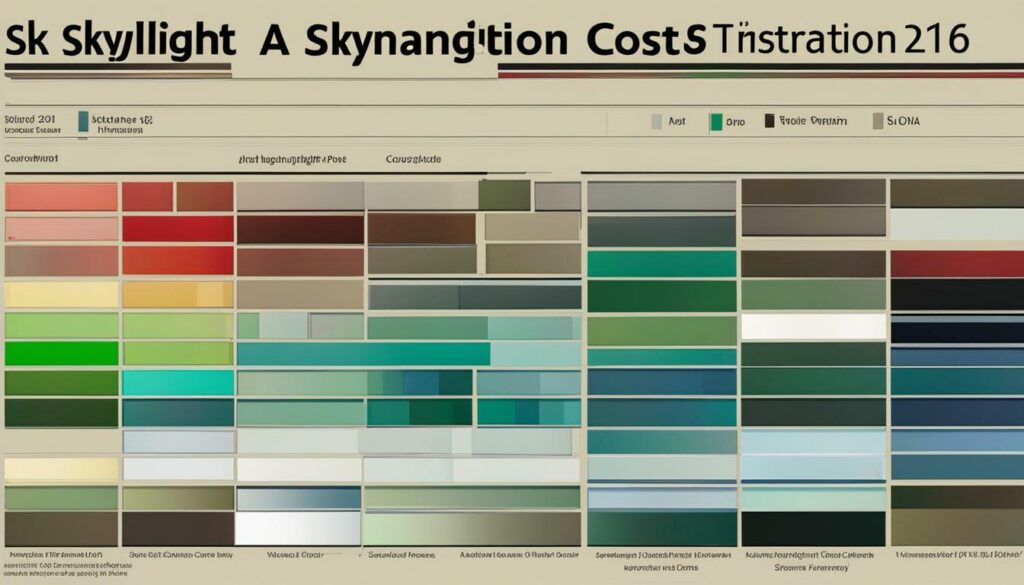
Having a clear understanding of the potential costs involved in skylight installation can help you make informed decisions and plan your budget accordingly. Remember to consider both the upfront costs and the long-term energy efficiency benefits when determining the overall value of your investment.
Enhancing Energy Efficiency
Apart from selecting the right glazing, there are other measures you can take to improve the energy efficiency of your skylight. These steps will not only help reduce your energy consumption but also contribute to a more comfortable and sustainable living environment.
One effective way to enhance energy efficiency is by using blinds or shades for your skylight. These window treatments can help regulate the amount of heat and sunlight entering your home. During hot summer months, closing the blinds or shades can prevent excessive heat gain and reduce the need for air conditioning. In winter, keeping them open during daylight hours can help maximize solar heat gain and reduce heating requirements.
Another important factor to consider is proper insulation around your skylight. Adequate insulation can significantly reduce heat loss in winter and heat gain in summer. Be sure to use quality insulation materials and seal any gaps or cracks around the skylight frame to prevent air leakage, which can compromise energy efficiency.
Furthermore, consider installing a skylight with a low-emissivity (low-E) coating. This coating helps minimize heat transfer by reflecting heat back into your home during winter and blocking out solar heat in summer. Low-E skylights can greatly improve energy efficiency and reduce the strain on your HVAC system.
By implementing these energy-efficient measures, you can enjoy the benefits of natural light while minimizing energy consumption and reducing your carbon footprint. Remember to consult with a professional for expert advice on skylight installation and energy-saving strategies tailored to your specific needs.
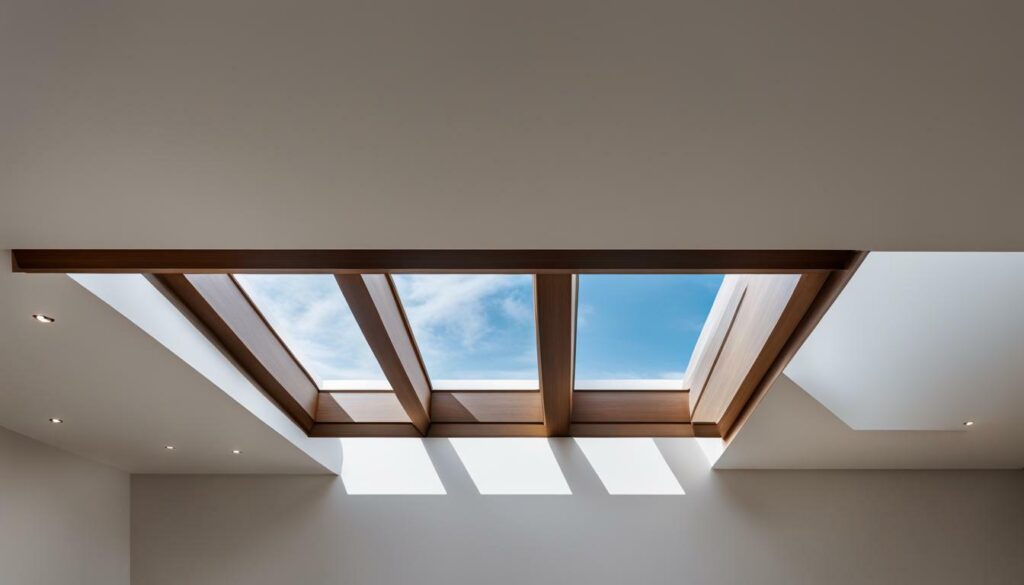
Regularly inspecting your skylight for leaks and damage is crucial to prevent water intrusion and ensure its longevity. Over time, even well-installed skylights can develop leaks or suffer damage from external elements. By conducting routine inspections, you can identify any issues early on and take the necessary steps to address them before they escalate.
Start by visually examining the skylight from both the interior and exterior. Look for any signs of water stains, discoloration, or moisture accumulation around the skylight frame or ceiling. These can indicate a leak or faulty seal. Inspect the glass or plastic glazing for cracks, chips, or scratches that could compromise its structural integrity.
In addition to visual inspections, it’s important to check for operational issues. Open and close the skylight to ensure it functions smoothly. Pay attention to any resistance or strange noises, as these can indicate mechanical issues. You should also check the surrounding roofing materials for signs of damage, such as missing or cracked shingles, which could contribute to water penetration.
Table: Checklist for Skylight Inspection
| Inspection Area | Checklist |
|---|---|
| Interior |
|
| Exterior |
|
| Operational |
|
If you detect any issues during the inspection, it’s important to address them promptly. Leaks or damage can worsen over time and lead to more significant problems, such as water damage or mold growth. Contact a professional skylight contractor to assess the issue and make the necessary repairs. Remember, DIY repairs may not be effective and can potentially cause further damage.
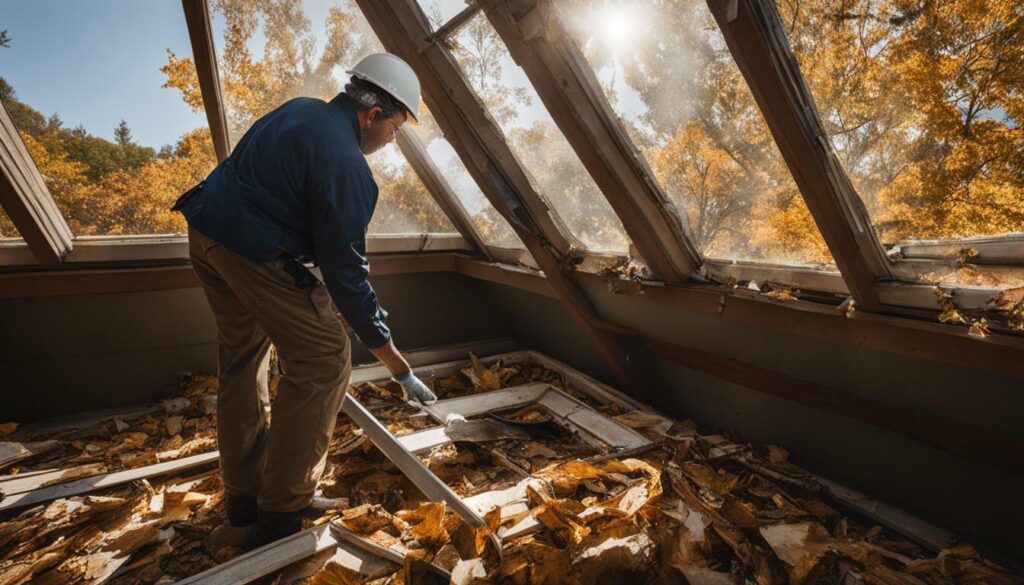
Regular maintenance and timely inspections are key to preserving the functionality and longevity of your skylight. By being proactive in identifying and addressing potential issues, you can ensure that your skylight continues to bring natural light into your home while protecting it from water intrusion and damage.
Cleaning and Care Tips
Keeping your skylight clean and well-maintained is key to preserving its appearance and performance over time. Regular cleaning will help remove dust, dirt, and debris that can accumulate on the surface and hinder the amount of natural light entering your home. Additionally, proper care and maintenance can prevent potential issues such as leaks and damage.
To clean your skylight, start by removing any loose debris with a soft brush or cloth. Avoid using abrasive materials or harsh chemicals that may scratch or damage the skylight. Instead, opt for a mild detergent mixed with water to gently clean the surface. Use a soft cloth or sponge to apply the solution, and then rinse thoroughly with clean water. Dry the skylight with a soft, lint-free cloth to prevent water spots.
Regularly inspecting your skylight for leaks and potential damage is essential. Check the surrounding area for any signs of water stains, mold, or discoloration, as these may indicate a leak. Pay particular attention to the seal around the skylight, as it can deteriorate over time. If you notice any issues, it is advisable to contact a professional for repair or replacement.
In addition to cleaning and inspections, it is important to maintain the surrounding area of your skylight. Keep tree branches and debris trimmed to prevent them from damaging the skylight or obstructing the natural light. It is also recommended to regularly check the skylight’s flashing, which helps to prevent water infiltration. If you notice any loose or damaged flashing, have it repaired immediately to avoid potential leaks.
Tips for Skylight Maintenance
- Clean your skylight at least twice a year, or more frequently if necessary, to remove dirt and grime.
- Use a mild detergent mixed with water to clean the skylight surface, avoiding harsh chemicals that may cause damage.
- Inspect the skylight for leaks, water stains, or mold regularly, especially after heavy rain or strong winds.
- Trim tree branches and remove any debris that could damage the skylight or obstruct the natural light.
- Check the skylight’s flashing for any signs of damage or deterioration, and have it repaired promptly if necessary.
- Consider applying a protective coating to the skylight to enhance its durability and resistance to weathering.
By following these cleaning and care tips, you can ensure that your skylight remains in optimal condition, providing you with natural light and enhancing the beauty of your home for years to come.
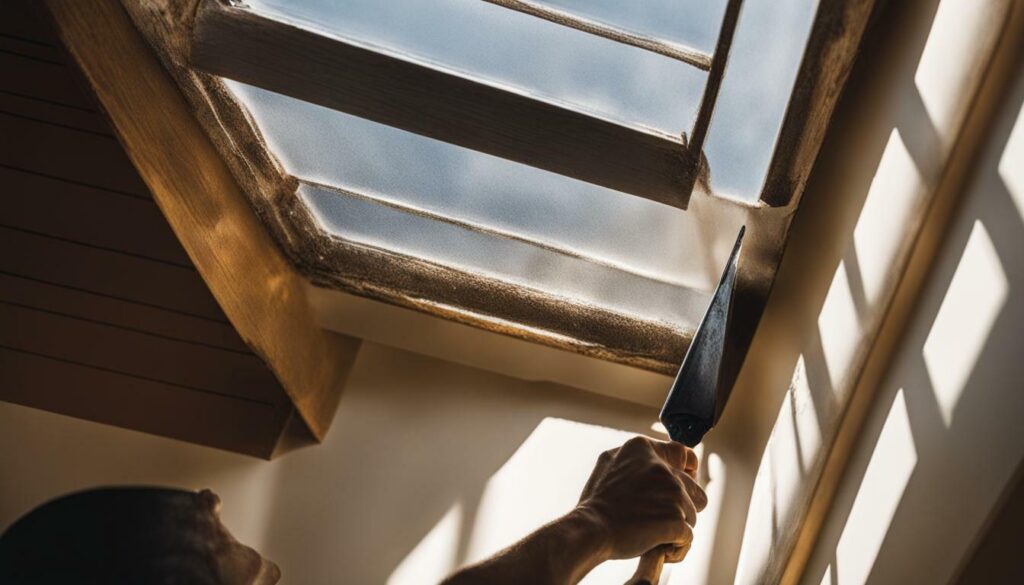
By carefully considering the skylight installation considerations discussed, you can ensure a successful and beneficial addition to your home.
When contemplating skylight installation, it’s essential to assess the suitability of your roof. Stick-framed roofs provide better support compared to truss-framed roofs, making them more compatible with skylights. Additionally, choosing the right glazing material is crucial. Glass is the preferred option due to its durability and insulation properties, although plastic glazing may be a more cost-effective alternative.
The location of your skylight is another crucial factor to maximize its benefits. North-facing skylights offer year-round illumination, providing consistent natural light throughout the seasons. However, it is important to note that skylight installation is a complex process that should be left to the professionals. Their expertise ensures a safe and effective installation.
Regular maintenance is key to keeping your skylight in optimal condition. Inspecting for leaks and potential damage is necessary to address any issues promptly. Additionally, cleaning the skylight using appropriate techniques will maintain its beauty and functionality over time.
Considering these skylight installation considerations will not only enhance the energy efficiency of your home but also create a visually stunning and well-lit space. By choosing the right skylight, assessing your roof’s suitability, and ensuring professional installation and regular maintenance, you can enjoy the benefits of natural light and create a more welcoming and comfortable living environment.
FAQ
Q: What factors should I consider when installing a skylight in my home?
A: There are several essential considerations to keep in mind when installing a skylight in your home. These include assessing your roof’s suitability, choosing the right skylight, understanding glazing options, maximizing natural light, hiring professionals for installation, regular maintenance and care, considering the costs, enhancing energy efficiency, inspecting for leaks and damage, and cleaning and care tips.
Q: How do I choose the right skylight for my home?
A: When choosing a skylight, consider factors such as its design, material options, and energy efficiency. Glass skylights are preferred for their durability and insulation properties, while plastic glazing is a cheaper alternative. Evaluate your needs and consult with professionals to select the most suitable skylight for your home.
Q: Is my roof suitable for a skylight installation?
A: Not all roofs are suitable for skylights. Stick-framed roofs are generally better suited for skylights, while truss-framed roofs are less ideal. It is crucial to assess your roof’s construction and condition to determine its suitability for a skylight installation. Consult with professionals for guidance.
Q: What are the different glazing options for skylights?
A: The type of glazing for a skylight is important, as it affects energy efficiency. Glass is the preferred option due to its durability and insulating properties. Plastic glazing is a cheaper alternative but may not provide the same level of insulation. Consider your energy efficiency requirements when choosing the right glazing for your skylight.
Q: How can I maximize natural light with skylight placement?
A: To maximize natural light, consider north-facing skylights as they provide continuous year-round illumination. Placing skylights strategically in areas where there are no obstructions such as trees or neighboring buildings can also enhance natural light in your home.
Q: Should I hire professionals for skylight installation?
A: Yes, it is recommended to leave skylight installation to professionals. It can be a complex and risky process that requires expertise and specialized tools. Hiring professionals ensures a safe and effective installation that minimizes the risk of leaks or structural issues.
Q: What maintenance tasks are required for skylights?
A: Regular maintenance is necessary to ensure the longevity of your skylight. Tasks include inspecting for leaks and damage, cleaning the skylight to remove dirt and debris, and ensuring proper sealing around the skylight frame. Regular maintenance will help keep your skylight functioning optimally.
Q: What are the typical costs associated with skylight installation?
A: The costs associated with skylight installation can vary depending on factors such as the size and type of skylight, the complexity of the installation, and any additional features or accessories. It is advisable to obtain quotes from reputable skylight installers to get a better understanding of the costs specific to your requirements.
Q: How can I enhance the energy efficiency of my skylight?
A: To enhance energy efficiency, consider options such as double-glazed skylights, low-emissivity coatings, and proper sealing. These features can help reduce heat loss and improve insulation. Consult with professionals to determine the best energy-saving options for your skylight.
Q: How do I inspect my skylight for leaks and potential damage?
A: Regularly inspect your skylight for signs of leaks, such as water stains or dampness around the skylight frame. Check for any cracks or damage to the glazing. It is essential to address any issues promptly to prevent further damage or water infiltration. Consult with professionals if you suspect any significant issues.
Q: What are the proper cleaning and care techniques for skylights?
A: Cleaning your skylight involves removing dirt, dust, and debris from both the interior and exterior surfaces. Use a non-abrasive cleaner and a soft cloth or sponge to avoid scratching the glazing. Regularly clean the surrounding area to prevent debris from accumulating on the skylight. Consult the manufacturer’s recommendations for specific cleaning instructions.
Q: Why is it essential to consider various factors when installing a skylight?
A: Considering various factors such as roof suitability, skylight selection, glazing options, and maintenance needs ensures a successful and beneficial skylight installation. By making informed decisions based on these considerations, you can enhance the functionality, energy efficiency, and longevity of your skylight.
